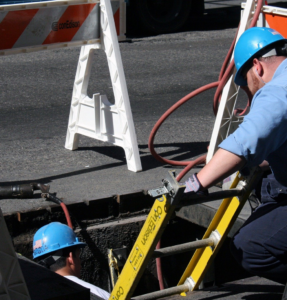 Includes FREE Downloadable February 2022 Safety Calendar!
Includes FREE Downloadable February 2022 Safety Calendar!
Silos, manure pits, and water towers. What do they have in common? It’s not a trick question. They certainly (thankfully!) don’t store the same products, but they do share a commonality: they’re confined spaces. Seems like identifying confined spaces is a breeze. But, when it comes to the workplace, identifying a confined space is more involved than just labelling any cramped space a confined space.
Confined Space Definition
Without having a clear understanding of what constitutes a confined space, you can’t confidently identify if there are any in your workplace. There’s a misconception that confined spaces are small or cramped. On the contrary, a confined space can be tiny, but it may also be quite large. To be considered a confined space, the space must satisfy the following criteria:
The Ministry of Labour, Training, and Skills Development (MLTSD) as well as Ontario Regulation 632/05, defines confined spaces as:
“A fully or partially enclosed space,
(a) that is not both designed and constructed for continuous human occupancy,
and
(b) in which atmospheric hazards may occur because of its construction,
location, or contents or because of work that is done in it.
If you have a space that is fully or partially enclosed, the two conditions:
(a) and (b) above – must both apply before the space can be considered a “confined space.”
How do I Know if it’s a Confined Space?
The only way to determine if a space is confined is to evaluate it:
- Is the space fully or partially enclosed?
- Is the space not both designed and constructed for continuous human occupancy?
- Might an atmospheric hazard occur?
Side note: Atmospheric hazards include oxygen deficiencies or surpluses, dust, chemical vapors, fumes, fog, mists and so on that may interfere with the body’s ability to transfer and use oxygen or may have adverse toxicological effects on human physiology.
Is it a Confined Space?
To help you identify confined spaces, read the following descriptions, and assess the space:
A Silo: A large silo is used to house chopped forage until it can be shipped out and converted to cattle feed. Is it a confined space?
The silo is fully enclosed. It’s not designed or constructed for human occupancy (although it is plenty large enough for a human being to fit inside of!). A silo containing chopped forage might create an atmospheric hazard. Yes, a silo is a confined space.
A Small Cubicle: A colleague’s cubicle is not big enough for her to stretch her arms out or turn around in her chair. The doorway is narrow, and she stores anti-bacterial wipes and sanitizing sprays under her desk. Is it a confined space?
It’s partially enclosed, and it might contain atmospheric hazards if the chemicals spill or get mixed up. However, although cramped, it’s designed for human occupancy. It was constructed to have a human inside of it. Therefore, it doesn’t meet the definition of confined space.
Trust the Experts
It’s up to the employer to determine how they evaluate confined spaces. However, many employers still struggle to correctly identify confined spaces. Especially where atmospheric hazards are concerned. It’s sometimes challenging to discern accurately whether a hazard “might” occur. To ensure that all confined spaces are correctly identified, most employers trust the experts at BEST Safety Training.
Identifying confined spaces is essential because you require a specific safety plan for entry into each space regardless of if you enter it all the time, just for maintenance and cleaning, or almost never. What’s more is that if you have identified confined spaces at your worksite, you also need an emergency response plan that is specific to those spaces in the event of an incident and subsequent rescue. Employers are responsible for assessing each space for potential and foreseeable hazards. BEST Safety Training offers services and training aimed at helping you determine whether spaces meet the confined space criteria. We can also assist you with creating, reviewing, or updating specific policies, programs, procedures with respect to confined spaces. BEST Safety Training will also get your team trained, or train one of your own to become a workplace trainer. Don’t get complacent when it comes to confined spaces.
Sign Up Today! Now Offering:
Confined Space Training via Distance Learning | February 10th, 2022
Confined Space Train-the-Trainer via Distance Learning | March 4th, 2022
Learn about how Train the Trainer programs can benefit your organization!
Not Sure Where to Start? BEST Safety Training Can Help
Download this FREE Confined Space Safety Awareness Calendar.